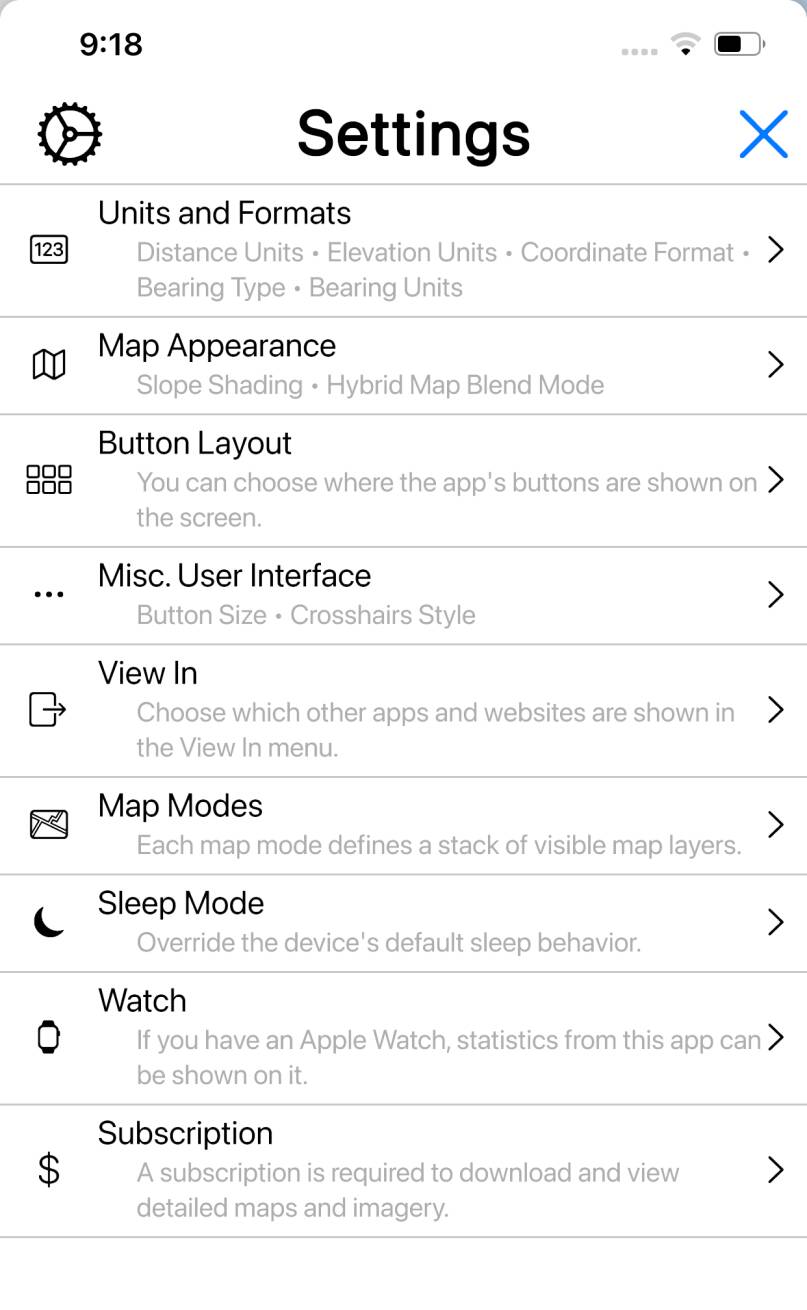
Tap the button to open the
settings screen. It has a number of subsections, which are described below.

Units and Formats
Distance Units
Choose the units used for distances in the scale and elsewhere.
Elevation Units
Choose the units used for elevations in the coordinate bar and elsewhere.
Coordinate Format
Choose the format for coordinates in the coordinate bar and elsewhere.
Latitude and longitude values can be shown in decimal degrees, degrees and decimal
minutes, or degrees, minutes and seconds. They can be shown in WGS84 or NAD27 datums.
UTM is a global grid reference format; see
Wikipedia.
There are two different conventions for the meaning of the letter in the UTM coordinates which
you can choose between; in the Hemisphere convention, it is N for the northern and S for the
southern hemisphere; in the Latitude Bands convention, it ranges from A to Z from the south
pole to the north pole.
MGRS stands for Military Grid Reference System; see
Wikipedia.
It is based on UTM but is formatted differently. USNG - United States National Grid - is
essentially the same as MGRS.
The app doesn’t support the exotic features of UTM and MGRS in the polar areas and around
the coast of Norway.
Bearing Type
Choose the type of bearing shown in the compass and elsewhere.
True bearings are relative to the geographic north pole. Magnetic bearings are
relative to the magnetic north pole; the app knows how this varies over time.
Grid bearings are relative to the grid lines of the local UTM grid; note UTM
is always used, even when maps with other projections are shown.
Bearing Units
Choose the units used for bearings shown in the compass and elsewhere.
NATO Mils are 1/6400ths of a circle; see
Wikipedia.

Map Appearance
Slope Shading
The app applies a shading effect to the map to give it a
3D effect, even in 2D mode. Use the slider to adjust the strength of the effect;
move it to the left to turn it off. Use the dial to set the direction of the
simulated sunlight; this looks most natural from the NW, despite this being an
unusual direction for sunlight in the northern hemisphere.
Hybrid Blend Mode
Choose how topos and imagery are combined in Hybrid map modes.

Button Layout
The controls in this section let you customize the buttons in the user interface.
The buttons are grouped into button boxes at the top and bottom of the
screen and in the pop-up that is shown when a point is selected.
Drag the buttons between the sections to move them between boxes.

Misc. User Interface
Button Size
You can select the size of the buttons. Large buttons are the default
and include the name of the feature. Once you are familiar with the app you might prefer
small buttons, which give more space for the map itself. Variable button size shows large
buttons for the the most recently used button-box and small buttons elsewhere.
Crosshairs Style
You can choose one of two styles for the crosshairs, which are
shown at the center of the screen; either a symbol, or
a full-screen, thin, gray cross. (The latter matches the style in the old Topo Maps app.)

View In
Use these settings to customize the button.
“View In” lets you view the area currently shown by this app in other apps
or websites. Here you can determine which apps and websites are shown in the menu,
change their order, and add additional ones.

Map Modes
These settings customize the Map Modes menu. You can choose which modes are
shown, re-order them by dragging, and add additional modes.
One reason for adding additional modes is to customize what happens when you
have more than one sort of map downloaded at the same location, i.e. both US Topo
and a Traditional Topo; which should the app prefer? Or you might want a mode
where one or other type is not shown at all.

Sleep Mode
Use this to control the device’s sleep behavior. This may be useful if you
have your device in e.g. a vehicle mount and you would like it to stay awake
while the app is running.

Watch
This section shows the current status of the connection to any paired
Apple Watch. Read More about Watch Support.

Subscription
This section shows the status of your subscription. Tapping
the “Manage Subscription” button will open a standard iOS subscription management
screen, which is also accessible from the Settings app.

